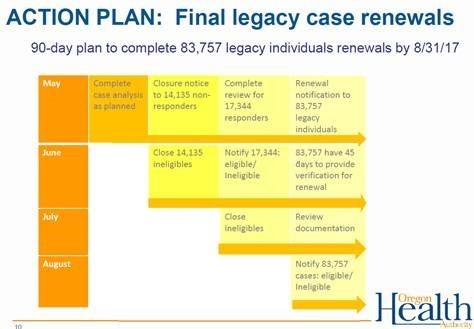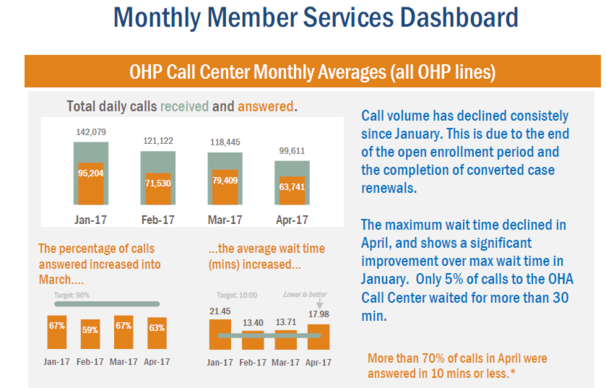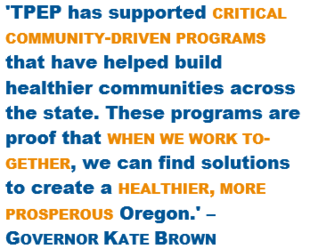 Over the past week, the Medicaid
eligibility and enrollment process has been in the news. While the Oregon
Health Authority (OHA) appreciates the Secretary of State’s shared commitment
to ensuring that the right Oregonians get the health care and benefits for
which they are eligible, we are concerned by the assertions contained in last
week’s “Auditor Alert,” which referenced preliminary information and did not
provide important Medicaid context for the Oregon Health Plan's renewal and
eligibility process. On Tuesday OHA
leadership testified to the Oregon Ways and Means Subcommittee on Human
Services to provide this context and correct misinformation.
The transition from the Cover Oregon
failure to the new ONE eligibility system has taken three years and is still
underway. We are in the final stages of this transition and the subsequent
anticipated clean-up of individual cases. As part of this final clean-up, OHA
has identified a number of individuals for whom further analysis is need to
determine what action, if any, is necessary. We are on track to complete this
analysis by May 31, and we have an action plan in place to complete all
renewals by August 31. It
is important to emphasizethat all of these individuals were
deemed eligible for at least a 12-month period, and just because a
renewal is not complete does not indicate that the individual is
ineligible for Medicaid.
|
 |
So that no OHP members would lose
access to health coverage during the transition to a new eligibility system,
Oregon asked the Centers for Medicare & Medicaid Services (CMS) for a
waiver to pause Medicaid eligibility renewals. This waiver and four subsequent
waivers were approved by CMS and the state until June 2016. OHA resumed the renewal process using the state’s new system for eligibility in March 2016.
Since then, OHA has completed 90 percent of this work. As of May 1, more than 733,695 eligible individuals were entered into the new ONE system.
Due to poor data quality from
OHA’s older legacy data systems, OHA had to contact each OHP member to have
them complete a paper application. The paper application was then manually
entered into the ONE system. This process took more than two years to complete.
What now remains are the final renewal cases that are more complex in nature due to reasons
that include multiple eligibility criteria and other household circumstances such as:
- Individuals who have a protected eligibility such as pregnant women or children under the age of 1 year.
- An
individual has not responded to the renewal paperwork but is connected
to an eligible case. For example, a child hasn’t responded but the
parent is eligible, so we have not terminated the child because we know
that the child is actually eligible if their parent is.
- An
individual has presumptive eligibility through categories like the
breast and cervical cancer program, extended medical or hospital
presumption.
- The individual is eligible but their case file is stuck in an old legacy system.
- Application was started in the ONE system but not finished due to procedural and system issues.
OHA anticipated that significant clean-up would be required once
we reached the end of the transition into the ONE system. OHA has reported on
this process on multiple occasions to the Governor, the Legislature and CMS
throughout the last three years.
OHA has added capacity through outside
contractors to assist and support in completing the final renewals, and
ensuring the system is audited for fraud and abuse. We are continuing to work
with the Governor, the Legislature and Secretary of State’s office to answer
questions about this process.
OHA will be providing a monthly dashboard to demonstrate the
progress related to member services. This dashboard will show the OHP call
center monthly averages and total OHP enrollment. This will provide greater
transparency and up-to-date information for the Governor, Legislature and
stakeholders.

SOS audit shows eligibility processed appropriately
While we still have work to do to
complete this transition, the good news is that we know the system works. In
fact on Wednesday the Secretary of State issued a final audit of the MMIS and
ONE systems that highlighted that 99.7 percent of the time, the systems accurately
determine eligibility, properly enroll individuals in coordinated care
organizations (CCOs), provide appropriate payments to CCOs and have a
reconciliation process in place to identify potential enrollment errors.
Oregon has made tremendous progress on
reducing the uninsured rate and transforming our health system. We are in the
last stages of finalizing the transition to the new eligibility system, which
will provide an improved process for all Oregon Health Plan members.
 |

Oregon Governor Kate Brown and the Oregon Health Authority held
two events last week in Salem and Cottage Grove to mark 20 years of tobacco
prevention successes in Oregon. OHA also announced its state tobacco prevention
strategies for the future, which will focus on raising the price of tobacco,
protecting the Indoor Clean Air Act (ICAA), and protecting kids from tobacco.
The events specifically celebrated Oregonians’ passage of a 1996
ballot measure that increased the price of tobacco and dedicated a portion of
tobacco sales tax revenue to prevention efforts.
These public health initiatives, backed by Oregon voters, aim to
keep kids and young people from starting to use tobacco, and to help tobacco
users quit. Since 1997, per capita cigarette pack sales have declined by more
than 55 percent.
Governor Brown thanked legislative champions and partners for their
hard work over the years to keep Oregonians, particularly youth and young
adults, safe from the harms of tobacco. She also presented an award to Oregon
high school students who are members of Rebels for a Cause, a student-led group
from Washington County, for their work to raise awareness about the dangers of
tobacco to Oregon youth. The award, a Douglas Fir tree to be planted at their
high school, symbolizes every Oregonian’s right to breathe clean air free from
dangerous tobacco smoke.
Oregon has been a longtime leader in tobacco prevention. In
1998, Oregon launched the Tobacco Quit Line, the first state to offer
over-the-phone help to tobacco users who want to quit. And in 2007 the state
passed the ICAA, a smokefree workplace law that included bars, taverns,
restaurants, bingo halls and bowling centers. In more recent years, Oregon
state parks became smokefree in 2014, and just this spring Lane County passed
Tobacco 21, increasing the legal age to purchase tobacco products to 21.
|

Legislative update
We’ve hit another session milestone as last Friday, May 19, which
was the second-chamber scheduling deadline. Next comes the second-chamber work
session deadline Friday, June 2––which means that after next Friday, only bills
in Ways and Means, Revenue, Rules and Joint committees will still be alive.
Some highlights from this week include:
Monday, May 22:
SB 934––Work session: requires all
payers to spend at least 12 percent on primary care by 2023––was heard by the House Committee on Healthcare.
Tuesday, May 23:
SB 1015––Public hearing:
specifies that industrial hemp and products do not include cannabinoid
concentrates or extracts––heard by the Joint Committee on Marijuana
Regulation.
HB 2198––Work session: changes
name of OLCC to Oregon Liquor and Cannabis Commission––heard by the Joint Committee on Marijuana
Regulation.
Wednesday, May 24:
SB 48––Work session: suicide
risk assessment continuing education bill––heard by the House Committee on Healthcare.
SB 1025A––Work session: creates
process for testing those who come into blood, fluid or bodily contact with
another for communicable diseases––heard by the House Committee on Healthcare.
Thursday, May 25:
HB 2015A––Work session: directs
OHA, with Traditional Health Workers Commission to review, and if necessary,
reimburse for doulas––heard by the Senate Committee on
Healthcare.
|